other British bats & vagrants
other British bats
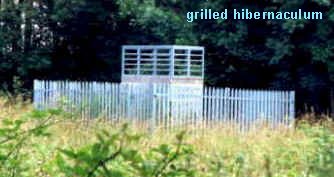 Bats are difficult to identify at the best of times - even using the
latest technology.
Bats are difficult to identify at the best of times - even using the
latest technology.
We have puzzled over many a 'mystery' bat on our bat walks, and maybe
we do have even more species than we thought......
This is a list of the bats that have (to the best of our knowledge) not
been recorded in Warwickshire but breed in the UK.
However, this doesn't meant that we don't have them!
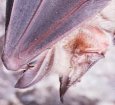 Greater
Horseshoe
Greater
Horseshoe
These bats get their name from the strange flap of skin around their nose
that is sort of horseshoe-shaped. They are called 'Greater' as they are
larger than their smaller cousins the Lesser Horseshoe bats (very logical
really - Spock would be proud). They are very fond of caves, especially
in the winter time. They are mainly found in the South West and Southern
Wales.
Grey Long-eared
Alcathoe
Greater Mouse-Eared
vagrants
Of course, not only may we have any of these local visitors, but there
could be a number of overseas tourists visiting our county. The following
bats are vagrants i.e. species that have been occasionally recorded in
the UK but are not thought to actually breed here.
kuhl's pipistrelle (pipistrellus kuhlii)
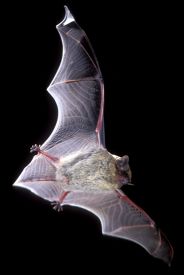 Like our own Pipistrelles this species has taken advantage of human structures
especially for its summer roosts. It is thought to use cliff crevices
and cellars in the winter. It is similar to other Pipistrelles but is
larger and tends to be lighter and yellowish coloured. Its fur colouring
can be very variable with medium or yellow brown shades on its dorsal
side and light grey fur on its underside. Its ears, nose and membranes
are a blackish brown colour.
Like our own Pipistrelles this species has taken advantage of human structures
especially for its summer roosts. It is thought to use cliff crevices
and cellars in the winter. It is similar to other Pipistrelles but is
larger and tends to be lighter and yellowish coloured. Its fur colouring
can be very variable with medium or yellow brown shades on its dorsal
side and light grey fur on its underside. Its ears, nose and membranes
are a blackish brown colour.
To date (2005) there is about 10 records; the first report occurring in
1991. One of these cases was when a holidaymaker returning home from Cyprus
opened their suitcase and out popped a Kuhl's Pipistrelle stowaway. Another
appeared near a Felixstowe dock.
Its normal range is throughout Southern Europe from Spain through France
to East Caucasus and is regarded mainly as a Mediterranean species but
recently has undergone an expansion of its range northwards. It is found
up to 51°N in the Ukraine and there is a maternity colony on Jersey.
It has a forearm length of 31 - 36 mm, a head and body length of 40 -
47 mm and a wingspan between 210 - 240 mm. Its weighs between 5 - 10 g.
northern bat or northern serotine (eptescicus nilssoni)
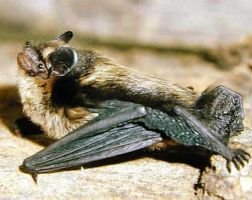 This
bat is widely distributed from eastern France to central Europe and much
of Scandinavia including above the Arctic Circle. Mainly a species of
woodland edge, it also occurs in farmland and villages. It roosts in buildings
and occasionally hiding among boulders on the ground in caves. Like other
vagrants, this species is most likely to occur in autumn or winter.
This
bat is widely distributed from eastern France to central Europe and much
of Scandinavia including above the Arctic Circle. Mainly a species of
woodland edge, it also occurs in farmland and villages. It roosts in buildings
and occasionally hiding among boulders on the ground in caves. Like other
vagrants, this species is most likely to occur in autumn or winter.
It is similar in appearance to the Serotine
(Eptesicus serotinus) with a post-calcarial lobe, long shaggy dark
chestnut fur with gold tips and 2- 3mm of tail free from the membrane.
However with a forearm length of 37 - 44 mm it is a smaller bat and much
more richly coloured.
There are sporadic records of this bat in the UK. One comes from Surrey
where one was found wintering in the same site two years running. A couple
of records come from North Sea oil rigs.
notch-eared bat or geoffroy's bat (myotis emarginatus)
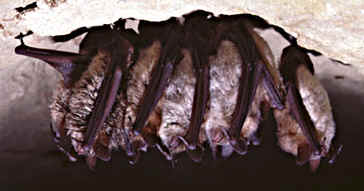 This
bat is found in caves and mines in winter and mainly in trees and buildings
in summer.
This
bat is found in caves and mines in winter and mainly in trees and buildings
in summer.
It is a medium-sized bat with a head and body length of 41 - 53 mm, a
wingspan of 220 - 245 mm and a weight of 7 - 15 g. It is distinguished
by a deep notch in the hind margin of each ear. Its long dense and shaggy
fur has a reddish woolly appearance on the underside; especially near
the tail. Its ears resemble those of a Natterer's
but are parallel when viewed from the front (Natterer's are splayed).
parti-coloured bat (vespertillio murinus)
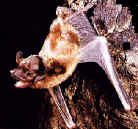 There
are 2 records of this bat in the 1800s, one found around the port of Yarmouth
and another from the port of Plymouth. Between 1927 and 1984 three turned
up in Shetland and there continue to be reports from the islands. It has
been confirmed on the UK mainland at least six more times.
There
are 2 records of this bat in the 1800s, one found around the port of Yarmouth
and another from the port of Plymouth. Between 1927 and 1984 three turned
up in Shetland and there continue to be reports from the islands. It has
been confirmed on the UK mainland at least six more times.
It is a well-known migrant with recorded movements of up to 850 km and
has turned up occasionally on North Sea oil rigs and ships. It occurs
in woodland and farmland but also frequently in towns. Summer roosts are
in trees, buildings and rock fissures. In winter it can be found in deeper
caves and cellars or even high in buildings.
It is a medium-sized bat with forearm length of 39 - 49 mm and long claws.
It has squarish ears and a short curved tragus with a blunt round end.
Its fur has dark brown base and light tips and its head and ears are a
dark brown colour. Its underside fur is strikingly white or grey compared
to that on its back and its skin is dark brown. The ears and membranes
are thin and translucent. The tip of the tail extends 4 - 5 mm beyond
the membrane.
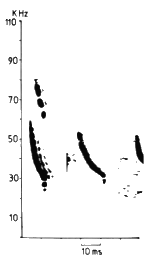 pond
bat (myotis dasycneme)
pond
bat (myotis dasycneme)
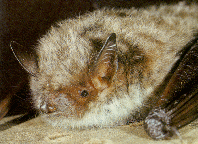 As its name suggests this bat is likely to be found near water. It is
a northern European species that undertakes short migrations. In winter
it roosts mainly in caves, while summer roosts are frequently in the roofs
of buildings or church towers.
As its name suggests this bat is likely to be found near water. It is
a northern European species that undertakes short migrations. In winter
it roosts mainly in caves, while summer roosts are frequently in the roofs
of buildings or church towers.
It is similar in appearance to Daubenton's
but is larger with a thick-set head. It is a medium-sized species with
a forearm length of 43 - 49 mm, a head and body length of 57 - 67 mm,
wingspan of 200 - 320 mm and a weight of 14 - 20 g. The fur is greyish-brown
often with pale tips with the whitish underfur extending on to the undersurface
of the tail membrane near the leg as far as the notably large feet.
The echolocation calls of the Pond Bat are similar to all the other Myotis
species i.e. frequency modulated sweeps from about 100 kHz to about 20
kHz. However, the peak frequency (loudest part) of the call is at about
35 kHz compared to 45-50 khz for all other UK Myotis
species. It
can also be recognised by a curved middle part to the sweep, sometimes
extending to a long, almost constant frequency part. In flight it's like
a large Daubenton's bat, but faster and not quite as agile.
In March (2005) it was confirmed that a Pond Bat (Myotis dascyneme)
had been found in Kent. The bat was in a wall in Ramsgate and was rescued
by Les Hoare of the Kent
Bat Group in September last year. Unfortunately the bat died shortly
after, although Les found no obvious injuries, and like all dead bats
it was sent to the Veterinary
Laboratories Agency (VLA) in Weybridge.
little brown bat (myotis lucifugus)
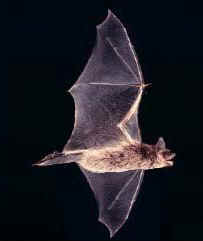 All
the way from North America (probably by ship). These bats roost in natural
cavities such as under the bark of trees. In urban settings they live
in or on areas of buildings for shelter and maternity colonies
All
the way from North America (probably by ship). These bats roost in natural
cavities such as under the bark of trees. In urban settings they live
in or on areas of buildings for shelter and maternity colonies
This bat is similar to Daubenton's but has
an ear length of 14 - 18 mm (Daubenton's: 8 - 12 mm) and its fur is not
dull but sleek and glossy. The fur colouring varies from yellowish and
brown to nearly black, with the under parts being noticeably lighter.
Flight membranes and ears are very dark brown. The feet are covered with
long fine hairs extending beyond the claws. It is a small to medium sized
bat with a wingspan of only 220 - 270 mm weighing between 5 - 11 g.
big brown bat (eptesicus fuscus)
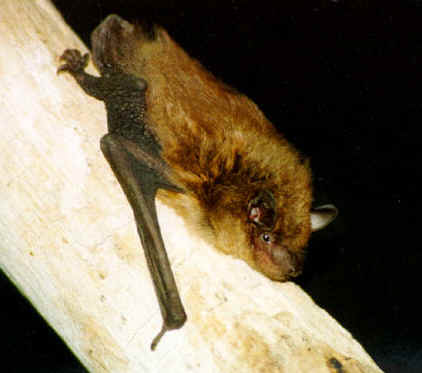 Another
bat from North America that usually finds passage on a ship to this country.
Big Brown Bats will often choose to live year round in or on areas of
buildings for shelter, maternity colonies and hibernation. They will also
use more natural habitats such as hollow trees and caves. They do not
appear to be very social as they are often found alone or in small groups.
They also tend to hibernate alone until low temperatures force them to
congregate.
Another
bat from North America that usually finds passage on a ship to this country.
Big Brown Bats will often choose to live year round in or on areas of
buildings for shelter, maternity colonies and hibernation. They will also
use more natural habitats such as hollow trees and caves. They do not
appear to be very social as they are often found alone or in small groups.
They also tend to hibernate alone until low temperatures force them to
congregate.
It appears similar to the Serotine but it
is usually smaller with a forearm length of 42 - 51 mm. The posterior
edge of the curved tragus has a distinct abrupt bend in the lower third
of its structure whereas the Serotine has a smoothly curved tragus. It
is a medium sized bat with a wingspan of 320 to 390 mm and their weight
is between 11 - 25 g. The colour of their fur varies from between yellowish
and brown to nearly black. Flight membranes and ears are very dark brown.
hoary bat (lasiurus cinereus)
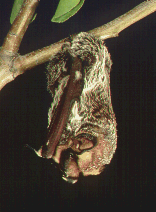 Hoary
bats are the most widespread of any American bat and are the only bat
known to occur in the Hawaiian Islands. Considered a solitary bat, they
roost primarily among foliage in trees, but have been found to roost under
planks, in caves, in cavities made by other animals, and under leaves
on the ground. The thick fur on Hoary bats provides great insulation and
they can tolerate a great temperature range.
Hoary
bats are the most widespread of any American bat and are the only bat
known to occur in the Hawaiian Islands. Considered a solitary bat, they
roost primarily among foliage in trees, but have been found to roost under
planks, in caves, in cavities made by other animals, and under leaves
on the ground. The thick fur on Hoary bats provides great insulation and
they can tolerate a great temperature range.
A large bat with a forearm length of 46 - 58 mm. Its dorsal hairs are
tipped white giving a frosted appearance and the tail membrane is completely
furred on the dorsal side. It is among the largest of North American bat
species, measuring 130-140 mm in length and possessing a wing-spread of
almost 384 - 415 mm. The bat's fur is a dark mahogany brown with silver
frosting over the back.
In 1847 a Hoary bat turned up on South Ronaldsay which is one of the
Orkney Islands. Although it is known to be a long-range migrant and has
turned up in Iceland, where it is not a resident species, it is doubtful
that it could have made the trip across the Atlantic without the help
of a ship of some sort.
silver-haired bat (lasionycteris noctivagans)
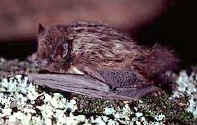 Between
1980 and 1999 there have been 2 records of this species. Both had been
assisted on their travels by humans. One was found in the cockpit of a
US plane and another amongst some imported wood.
Between
1980 and 1999 there have been 2 records of this species. Both had been
assisted on their travels by humans. One was found in the cockpit of a
US plane and another amongst some imported wood.
The silver-haired bat is a medium sized bat. It has a wingspan of 270
- 310 mm and a forearm length of 37 - 44 mm. It receives its name from
its dark, silver-tipped fur. The bat's fur is usually black in colour,
however some individuals may be dark brown with yellow-tipped fur with
relatively short round and naked ears.
european free-tailed bat (tadarida teniotis)
 In
2003 a male of the species decided to come and visit the UK, or more precisely
a Cornish churchyard where he was discovered by a dogwalker. Luckily for
him he was taken in by Cornwall Bat Hospital as he was very weak and underweight.
In
2003 a male of the species decided to come and visit the UK, or more precisely
a Cornish churchyard where he was discovered by a dogwalker. Luckily for
him he was taken in by Cornwall Bat Hospital as he was very weak and underweight.
Free-tails are very distinctive large bats with a tail that hangs freely
behind them. Having very long narrow wings they are very able fliers,
and have been recorded reaching speeds of 60kph with a tail-wind (excuse
the pun).The ears are long and broad, protrubing forward over the eyes
its wrinkled "bulldog" face. The European Free-tailed bat inhabits
warm Mediterranean regions. They roost in cracks in cliffs or in buildings,
even in large cities.
mexican free-tailed bat (tadarida brasiliensis)
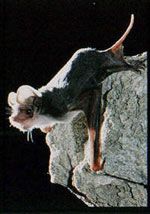 Another
North American bat to arrive in this country with 'assisted' passage is
the Mexican Free-tailed bat. In came in with a consignment of bananas.
It gets its name from the long mouse-like tail that extends beyond its
tail membrane. Its body is approx. 9cm long and has a wingspan of about
30cm. Its fur is a greyish-brown colour and is paler underneath. It has
a small wrinkled upper lip.
Another
North American bat to arrive in this country with 'assisted' passage is
the Mexican Free-tailed bat. In came in with a consignment of bananas.
It gets its name from the long mouse-like tail that extends beyond its
tail membrane. Its body is approx. 9cm long and has a wingspan of about
30cm. Its fur is a greyish-brown colour and is paler underneath. It has
a small wrinkled upper lip.
These bats live in caves in the southern United States, Mexico, Central
America, the West Indies, central Chile and Argentina. Their colonies
are the largest congregations of mammals in the world! The largest colony
is found at Bracken Cave, north of San Antonio, Texas, with nearly 20
million bats!
The 100 million Free-tailed bats living in Central Texas caves consume
approximately 1,000 tons of insects nightly, a large proportion of which
are agricultural pests. These clouds of bats are visible on weather radar
and researchers watch emerging bats ascend to altitudes of 1,000-10,000
feet to feed on migrating cotton boll worm moths, army cut-worm moths,
and other costly agricultural pests that migrate north from Mexico.